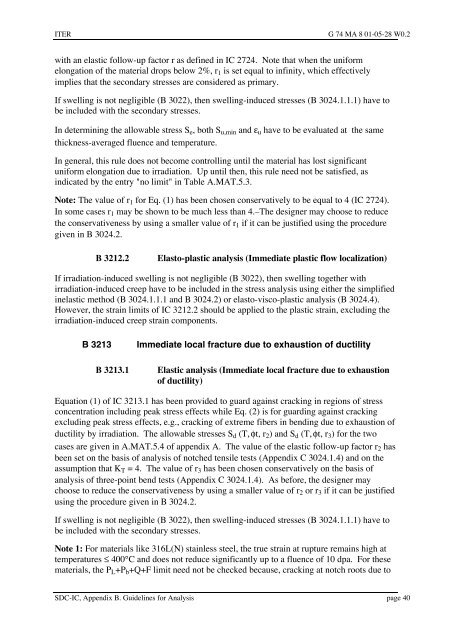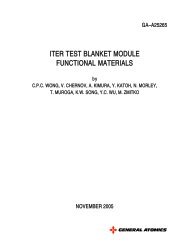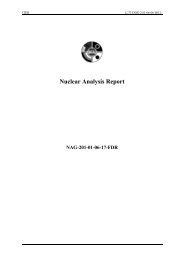iter structural design criteria for in-vessel components (sdc-ic)
iter structural design criteria for in-vessel components (sdc-ic)
iter structural design criteria for in-vessel components (sdc-ic)
Create successful ePaper yourself
Turn your PDF publications into a flip-book with our unique Google optimized e-Paper software.
ITER G 74 MA 8 01-05-28 W0.2<br />
with an elast<strong>ic</strong> follow-up factor r as def<strong>in</strong>ed <strong>in</strong> IC 2724. Note that when the uni<strong>for</strong>m<br />
elongation of the material drops below 2%, r1 is set equal to <strong>in</strong>f<strong>in</strong>ity, wh<strong>ic</strong>h effectively<br />
implies that the secondary stresses are considered as primary.<br />
If swell<strong>in</strong>g is not negligible (B 3022), then swell<strong>in</strong>g-<strong>in</strong>duced stresses (B 3024.1.1.1) have to<br />
be <strong>in</strong>cluded with the secondary stresses.<br />
In determ<strong>in</strong><strong>in</strong>g the allowable stress Se, both Su,m<strong>in</strong> and eu have to be evaluated at the same<br />
th<strong>ic</strong>kness-averaged fluence and temperature.<br />
In general, this rule does not become controll<strong>in</strong>g until the material has lost signif<strong>ic</strong>ant<br />
uni<strong>for</strong>m elongation due to irradiation. Up until then, this rule need not be satisfied, as<br />
<strong>in</strong>d<strong>ic</strong>ated by the entry "no limit" <strong>in</strong> Table A.MAT.5.3.<br />
Note: The value of r1 <strong>for</strong> Eq. (1) has been chosen conservatively to be equal to 4 (IC 2724).<br />
In some cases r1 may be shown to be much less than 4. The <strong>design</strong>er may choose to reduce<br />
the conservativeness by us<strong>in</strong>g a smaller value of r1 if it can be justified us<strong>in</strong>g the procedure<br />
given <strong>in</strong> B 3024.2.<br />
B 3212.2 Elasto-plast<strong>ic</strong> analysis (Immediate plast<strong>ic</strong> flow localization)<br />
If irradiation-<strong>in</strong>duced swell<strong>in</strong>g is not negligible (B 3022), then swell<strong>in</strong>g together with<br />
irradiation-<strong>in</strong>duced creep have to be <strong>in</strong>cluded <strong>in</strong> the stress analysis us<strong>in</strong>g either the simplified<br />
<strong>in</strong>elast<strong>ic</strong> method (B 3024.1.1.1 and B 3024.2) or elasto-visco-plast<strong>ic</strong> analysis (B 3024.4).<br />
However, the stra<strong>in</strong> limits of IC 3212.2 should be applied to the plast<strong>ic</strong> stra<strong>in</strong>, exclud<strong>in</strong>g the<br />
irradiation-<strong>in</strong>duced creep stra<strong>in</strong> <strong>components</strong>.<br />
B 3213 Immediate local fracture due to exhaustion of ductility<br />
B 3213.1 Elast<strong>ic</strong> analysis (Immediate local fracture due to exhaustion<br />
of ductility)<br />
Equation (1) of IC 3213.1 has been provided to guard aga<strong>in</strong>st crack<strong>in</strong>g <strong>in</strong> regions of stress<br />
concentration <strong>in</strong>clud<strong>in</strong>g peak stress effects while Eq. (2) is <strong>for</strong> guard<strong>in</strong>g aga<strong>in</strong>st crack<strong>in</strong>g<br />
exclud<strong>in</strong>g peak stress effects, e.g., crack<strong>in</strong>g of extreme fibers <strong>in</strong> bend<strong>in</strong>g due to exhaustion of<br />
ductility by irradiation. The allowable stresses Sd (T, ft, r2) and Sd (T, ft, r3) <strong>for</strong> the two<br />
cases are given <strong>in</strong> A.MAT.5.4 of appendix A. The value of the elast<strong>ic</strong> follow-up factor r2 has<br />
been set on the basis of analysis of notched tensile tests (Appendix C 3024.1.4) and on the<br />
assumption that KT = 4. The value of r3 has been chosen conservatively on the basis of<br />
analysis of three-po<strong>in</strong>t bend tests (Appendix C 3024.1.4). As be<strong>for</strong>e, the <strong>design</strong>er may<br />
choose to reduce the conservativeness by us<strong>in</strong>g a smaller value of r2 or r3 if it can be justified<br />
us<strong>in</strong>g the procedure given <strong>in</strong> B 3024.2.<br />
If swell<strong>in</strong>g is not negligible (B 3022), then swell<strong>in</strong>g-<strong>in</strong>duced stresses (B 3024.1.1.1) have to<br />
be <strong>in</strong>cluded with the secondary stresses.<br />
Note 1: For materials like 316L(N) sta<strong>in</strong>less steel, the true stra<strong>in</strong> at rupture rema<strong>in</strong>s high at<br />
temperatures £ 400¡C and does not reduce signif<strong>ic</strong>antly up to a fluence of 10 dpa. For these<br />
materials, the PL+Pb+Q+F limit need not be checked because, crack<strong>in</strong>g at notch roots due to<br />
SDC-IC, Appendix B. Guidel<strong>in</strong>es <strong>for</strong> Analysis page 40




